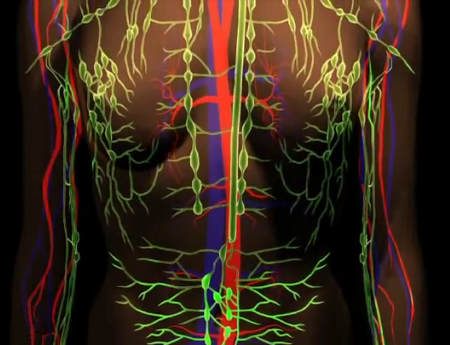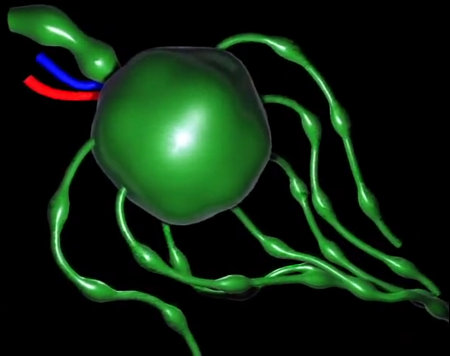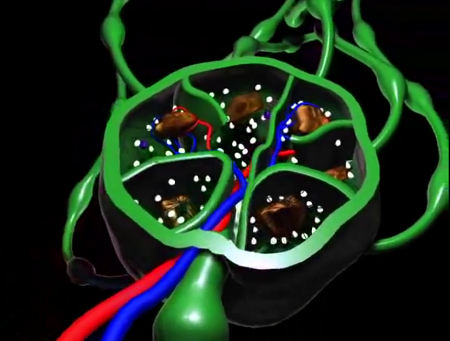Enlarged Lymph Nodes: Overview
Alternative names: Enlarged lymph glands, Lymphadenopathy, Adenopathy, Lymphadenitis,
The lumps that you feel in your neck or under your jaw when you have a cold or a sore throat are called lymph nodes. Inflamed or enlarged lymph nodes can be a sign of a wide variety of disease conditions, ranging from a simple cold all the way to cancer. The location of the affected lymph nodes is often a good clue as to where the problem lies.
- let The Analyst™ find what's wrong
- check your overall health status
- understand what's happening to your body
The lymphatic system is present throughout the body. In fact, the lymph system vessels are just as extensive as those of the circulatory system.

The lymphatic system is a complex network of thin vessels, valves, ducts, nodes and organs (for example the tonsils, spleen, and thymus). It helps to protect and maintain the fluid environment of the body by producing, filtering and conveying lymph, and by producing various immune blood cells. Lymph is a clear liquid containing white blood cells, proteins, salts, and water.
Lymph nodes are small, bean-shaped glands located throughout the body, all having the same function. The average human body has some 500-600 lymph nodes, with clusters found in the neck, armpits, chest, abdomen, and groin. They are part of the body's immune system and play an important part in the body's defense against infection: they help to destroy infectious agents and produce antibodies that will help prevent the same infection from occurring again in the future.
Each part of the body is served by its own network of lymph vessels, which drain into specific lymph nodes. For example, the arms and breasts drain into the lymph nodes under the armpits.
Causes and Development

Lymph nodes are filters that can catch malignant tumor cells or infectious organisms. When they do, lymph nodes increase in size and are easily felt. Swelling can occur even if the infection is trivial or not apparent.
Swelling of lymph nodes generally results from localized or systemic infection, abscess formation, or malignancy; other causes of enlarged lymph nodes are extremely rare. By far the most common cause of lymph node enlargement is infection. As a rule, when swelling appears suddenly and is painful, it is usually caused by injury or an infection. Enlargement that comes on gradually and painlessly may result from malignancy or tumor.
Common causes of enlarged lymph nodes (and their usual location):
- Localized infection (nodes serving that part of the body)
- Infectious mononucleosis (armpits, behind the ears or neck)
- Rubella, also known as German measles (behind the ears)
- Chickenpox (behind the ears, back of the neck, armpits)
- Mumps (salivary glands)
- Tuberculosis (above the collar bone)
- Ear infections or sore throat (neck glands, sometimes)
- Infection in the scalp (behind the ears or in back of the head)
- Impacted tooth / swollen gums (under the jaw)
- HIV or AIDS (neck, armpits, groin)
- Cat-scratch disease (often armpit nodes because scratches are usually on the arms/hands)
- Juvenile Idiopathic Arthritis (anywhere)
- Serum sickness (near the site of injection, head, neck)
- Leukemia, Acute Lymphocytic Leukemia (ALL) (generalized lymphadenopathy – throughout the body)
- Hodgkin's disease (neck, armpits, and/or groin)
- Non-Hodgkin's lymphoma (neck, armpits, and/or groin)
- Canker sores (under the jaw)
- Herpes zoster / shingles (neck, armpit, or groin)
- Certain medications, such as the anti-seizure medication phenytoin, certain antimalarial drugs, sulfa drugs, iodine, penicillin (near the site of administration, or anywhere)
- Certain vaccinations, such as smallpox, typhoid, measles-mumps-rubella (near the site of vaccination, armpit)
- Salivary duct stones
- Sporotrichosis (fungal infection of the skin) (near site of infection)
Signs and Symptoms

When lymph nodes are actively fighting infection, they may become swollen and painful as they produce and store large numbers of antibodies. Usually, the pain is mild, and the lymph node does not get much bigger than 2 centimeters (slightly under 1 inch) in size.
Common areas where enlarged lymph nodes can be felt (palpable nodes) include the groin area (inguinal region), armpit (axilla), the neck (there is a chain of lymph nodes on either side of the front of the neck, both sides of the neck, and down each side of the back of the neck), under the jaw and chin, behind the ears, and over the occiput (prominence on the back of the head). There are also lymph nodes that cannot be felt, in the abdomen, pelvis and chest.
Lymphangitis is a viral or bacterial infection in the lymphatic vessels which is characterized by painful, red streaks below the skin surface. This is a potentially serious infection which can rapidly spread to the bloodstream and be fatal. Aside from enlarged lymph nodes, other symptoms may include chills, fever, malaise, poor appetite, headache, and muscle aches.
Diagnosis and Tests
Any persistently swollen lymph gland requires careful diagnostic study. Since enlarged lymph nodes are often near the source of infection, their location can help determine the cause.
While lymph nodes are the most common cause of a lump or a bump under the skin, there are other less common causes which should be ruled out:
- lipomas (harmless fatty growths)
- benign cysts
- normal breast tissue (breast tissue extends into the armpit area)
- cysts and superficial infections in the skin of the armpit after shaving or use of antiperspirants (which block pores)
- subcutaneous abscesses may produce large painful lumps in the armpits or elsewhere
- cysts from abnormalities of fetal development
- thyroid gland enlargement
A doctor can usually tell the difference upon physical examination.
Treatment and Prevention
Treatment of enlarged lymph nodes involves identifying the underlying medical condition and treating that. For example, a lump in the armpit caused by breast cancer is treated by following the appropriate cancer treatment.
Generally, if you have symptoms of a cold or other minor infection, give the glands about 2 weeks to go back to normal. No specific treatment is needed. If the glands are small (less than 2cm or ¾ inch across), are in your groin or under the chin, and you are a young adult, this is considered normal. Children tend to have a more active lymphatic system, so their glands may feel enlarged from time to time.
Prognosis; Seek medical attention if...
Soreness in lymph glands usually disappears in a couple of days without treatment. Glands become painful due to the rapid swelling of the gland in the early stages of fighting the infection. It takes much longer for the gland to return to normal size than it did to enlarge.
A lump in the armpit or elsewhere caused by a generalized viral infection will eventually disappear without therapy. A lump caused by an allergic reaction will go away after the allergen is removed.
Call your health care provider if:
- after several weeks of observation the glands do not get smaller
- swollen glands are red and tender
- glands are hard, fixed to the skin, or are growing rapidly
- swollen glands are located behind the ear and there is also a scalp infection
- symptoms such as weight loss, night sweats, fatigue, or prolonged fever are also present
- one or more glands get larger over a period of 2-3 weeks.
On This Page
Enlarged Lymph Nodes:Signs, symptoms & indicators of Enlarged Lymph Nodes:
Symptoms - Abdomen
Symptoms - Glandular
Risk factors for Enlarged Lymph Nodes:
Autoimmune
Tumors, Malignant
Click to see sample report
Your body is a highly complex, interconnected system. Instead of guessing at what might be wrong, let us help you discover what is really going on inside your body based on the many clues it is giving.
Our multiple symptom checker provides in-depth health analysis by The Analyst™ with full explanations, recommendations and (optionally) doctors available for case review and answering your specific questions.
KEY









